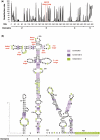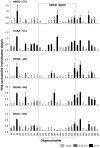Structural basis for the biological relevance of the invariant apical stem in IRES-mediated translation
- PMID: 21742761
- PMCID: PMC3201876
- DOI: 10.1093/nar/gkr560
Structural basis for the biological relevance of the invariant apical stem in IRES-mediated translation
Abstract
RNA structure plays a fundamental role in internal initiation of translation. Picornavirus internal ribosome entry site (IRES) are long, efficient cis-acting elements that recruit the ribosome to internal mRNA sites. However, little is known about long-range constraints determining the IRES RNA structure. Here, we sought to investigate the functional and structural relevance of the invariant apical stem of a picornavirus IRES. Mutation of this apical stem revealed better performance of G:C compared with C:G base pairs, demonstrating that the secondary structure solely is not sufficient for IRES function. In turn, mutations designed to disrupt the stem abolished IRES activity. Lack of tolerance to accept genetic variability in the apical stem was supported by the presence of coupled covariations within the adjacent stem-loops. SHAPE structural analysis, gel mobility-shift and microarrays-based RNA accessibility revealed that the apical stem contributes to maintain IRES RNA structure through the generation of distant interactions between two adjacent stem-loops. Our results demonstrate that a highly interactive structure constrained by distant interactions involving invariant G:C base pairs plays a key role in maintaining the RNA conformation necessary for IRES-mediated translation.
Figures






Similar articles
-
Structural and functional analysis of the 5' untranslated region of coxsackievirus B3 RNA: In vivo translational and infectivity studies of full-length mutants.Virology. 1999 Dec 20;265(2):206-17. doi: 10.1006/viro.1999.0048. Virology. 1999. PMID: 10600593
-
Structural elements in the 5'-untranslated region of giardiavirus transcript essential for internal ribosome entry site-mediated translation initiation.Eukaryot Cell. 2005 Apr;4(4):742-54. doi: 10.1128/EC.4.4.742-754.2005. Eukaryot Cell. 2005. PMID: 15821134 Free PMC article.
-
Evidence of reciprocal tertiary interactions between conserved motifs involved in organizing RNA structure essential for internal initiation of translation.RNA. 2006 Feb;12(2):223-34. doi: 10.1261/rna.2153206. Epub 2005 Dec 22. RNA. 2006. PMID: 16373480 Free PMC article.
-
Relevance of RNA structure for the activity of picornavirus IRES elements.Virus Res. 2009 Feb;139(2):172-82. doi: 10.1016/j.virusres.2008.07.009. Epub 2008 Aug 15. Virus Res. 2009. PMID: 18692097 Review.
-
An atypical IRES within the 5' UTR of a dicistrovirus genome.Virus Res. 2009 Feb;139(2):157-65. doi: 10.1016/j.virusres.2008.07.017. Epub 2008 Sep 11. Virus Res. 2009. PMID: 18755228 Review.
Cited by
-
RNAiFold2T: Constraint Programming design of thermo-IRES switches.Bioinformatics. 2016 Jun 15;32(12):i360-i368. doi: 10.1093/bioinformatics/btw265. Bioinformatics. 2016. PMID: 27307638 Free PMC article.
-
Alternative Mechanisms to Initiate Translation in Eukaryotic mRNAs.Comp Funct Genomics. 2012;2012:391546. doi: 10.1155/2012/391546. Epub 2012 Feb 16. Comp Funct Genomics. 2012. PMID: 22536116 Free PMC article.
-
Deconstructing internal ribosome entry site elements: an update of structural motifs and functional divergences.Open Biol. 2018 Nov 28;8(11):180155. doi: 10.1098/rsob.180155. Open Biol. 2018. PMID: 30487301 Free PMC article. Review.
-
Rab1b and ARF5 are novel RNA-binding proteins involved in FMDV IRES-driven RNA localization.Life Sci Alliance. 2019 Jan 17;2(1):e201800131. doi: 10.26508/lsa.201800131. Print 2019 Feb. Life Sci Alliance. 2019. PMID: 30655362 Free PMC article.
-
Secondary structures in RNA synthesis, splicing and translation.Comput Struct Biotechnol J. 2022 May 27;20:2871-2884. doi: 10.1016/j.csbj.2022.05.041. eCollection 2022. Comput Struct Biotechnol J. 2022. PMID: 35765654 Free PMC article. Review.
References
-
- Spriggs KA, Bushell M, Willis AE. Translational regulation of gene expression during conditions of cell stress. Mol. Cell. 2010;40:228–237. - PubMed
-
- Vallejos M, Deforges J, Plank TD, Letelier A, Ramdohr P, Abraham CG, Valiente-Echeverria F, Kieft JS, Sargueil B, Lopez-Lastra M. Activity of the human immunodeficiency virus type 1 cell cycle-dependent internal ribosomal entry site is modulated by IRES trans-acting factors. Nucleic Acids Res. 2011 April 10; epub ahead of print; doi:10.1093/nar/gkr189. - PMC - PubMed

